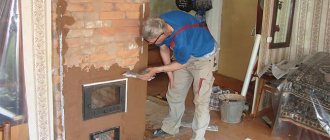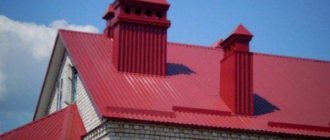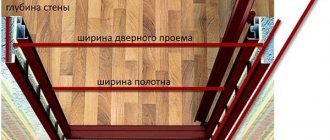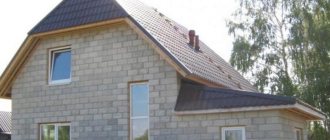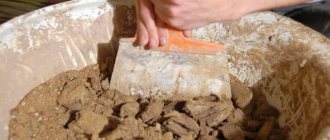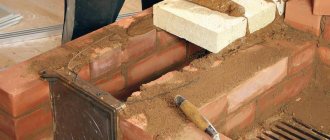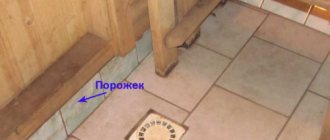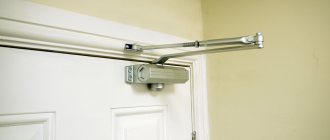Where to begin?
And the beginning of everything is making molds.
Forms
There are molds for building blocks with standard sizes on sale. And at home you can make building blocks in sizes that suit you. We take sheet metal, cut out the required shape from it and weld the shape. Molds are also made from wood; they are good for adobe blocks. There is no need for a bottom here. But the handles on the sides will come in handy, it’s more convenient to work with them.
Features of storing cinder blocks
Often, cinder blocks are stacked in pyramidal stacks of 100 pieces, leaving a small distance between them.
After about a couple of months, when they harden, they can be used to build a house, bathhouse or barn.
Material for homemade building blocks
What's great about DIY building blocks is that they use material that you already have or can easily purchase.
Basically, blocks are made from cement with various fillers, but craftsmen, like manufacturers, sometimes do without it. Depending on the selected material, it is possible to produce homemade building blocks of the following types:
- slag concrete;
- blocks based on liquid glass;
- adobe;
- chip concrete or wood concrete.
How the filler is used:
- ash;
- slag;
- dropout;
- crushed stone;
- gypsum;
- perlite;
- expanded clay;
- sawdust;
- straw;
- broken bricks and more.
Sizes and selection rules
Dimensions of blocks for building a house
State standards standardize the dimensional parameters of blocks for wall masonry. Standardization helps to correctly calculate the volume of material. The list includes solid stones or blocks with holes for communications.
Dimensions of wall elements:
- expanded clay concrete stones, solid and hollow - 40x20x20 cm;
- gas silicate - 60x25x40 cm and 60x25x50 cm;
- foam concrete - 60x30x25 cm and 60x40x20 cm;
- polystyrene - 60x30x25 cm and 40x20x20 cm;
- wood concrete - 15x20x50 cm, 20x20x50 cm and 30x20x50 cm;
- ceramic - 25x12x6.5 cm, 25x12x14 cm, 25x25x14 cm, 51x9.5x22 cm.
When choosing materials, their cost and thermal conductivity, as well as labor costs for the construction of vertical structures, are taken into account. They take into account the need for insulation, waterproofing and decorative finishing, which will entail costs. What matters is the strength and load-bearing characteristics of the finished wall, its fire hazard, saturation with moisture and environmental cleanliness.
Blocks without cement
Making building blocks using this technology is not available to everyone, because the mixture contains liquid glass. Unless you negotiate with the nearest concrete products plant and buy the main component there. The mixture will consist of:
- two dozen parts of river sand;
- one and a half dozen parts of liquid glass;
- 4 parts chalk;
- 3 parts slaked lime;
- 2 parts kaolin.
Manufacturing process
- First the sand is sifted;
- chalk is added;
- everything mixes well;
- slaked lime is introduced;
- kaolin or brick crushed to a powder state;
- liquid glass.
The starting raw material should be homogeneous and dough-like. Before pouring this dough-like mass, wet the inside of the molds. If you wish, you can add color to the building blocks. To do this add:
- chalk of any color;
- red brick ground into powder.
Fillers are added to such blocks: slag, expanded clay, shavings. Their strength is high - they are much stronger than cement ones.
Read on to find out more!
Basement and foundation waterproofing
What do you need to know before laying the foundation?
Driving piles
Where to buy reinforcement for the foundation
House foundation price
Columnar foundation
- 2.69
Rating: 2.7 out of 5 Votes: 139
- 1
Reply
6 years ago
Expanded clay concrete blocks
Expanded clay concrete blocks are one of the types of cinder blocks, where expanded clay serves as a filler.
Compound
- cement - 1 part;
- expanded clay - 5 parts;
- sand - 3 parts;
- water - about one part.
Technology
The technology for manufacturing expanded clay concrete building blocks is generally the same as any other:
- the starting material is placed in pre-lubricated molds;
- compacted;
- the form is removed after 10 minutes;
- the product remains in place;
- after 12 hours it is transferred to a place protected from precipitation and direct sunlight.
- in warm weather the blocks will become hard in a little less than a month.
If you plan to make thick walls (about 0.5 m), then blocks with voids are better. To do this, wooden inserts are inserted into the mold: round or square. And so that they can be easily removed, before inserting, wrap them in roofing iron.
Advantages
- light weight;
- frost resistance;
- breathability;
- moisture resistance;
- strength;
- low cost.
A house made from expanded clay concrete blocks is built faster than from brick; less mortar is needed for masonry.
DIY polystyrene concrete walls
These blocks are large in size and light in weight. Therefore, labor productivity when performing masonry work with them is quite high. It is worth knowing that thin seams are needed for masonry. Their thickness for the outer layer is about 15 mm, and for the inner layer - at least 20. The solution must be made from:
- cement,
- water,
- additives for strength,
- parts of foamed polystyrene.
Considering that the main disadvantage of polystyrene concrete is that it is not very durable (the process of destruction begins 20 years after its manufacture), the masonry of walls must necessarily include external treatment of the seams with the same mortar that held the blocks together. The thickness of the walls is usually one block, since this material is very warm.
Adhesive for laying polystyrene concrete blocks
Craftsmen recommend adding special glue to the masonry solution. But it’s still better to either put it on cement mortar or glue, that is, do not mix these materials. The use of glue allows you to minimize the “cold bridges” that are masonry joints, and thereby reduce its consumption.
Typically, glue has low thermal conductivity (it varies, and the price depends on it, so you need to choose the glue based on this characteristic and taking into account the climatic zone of your residence). It is also worth considering that glue is ideal for the construction of low-rise buildings.
More clearly about how to lay polystyrene concrete blocks on glue:
Features of building a house made of polystyrene concrete
Polystyrene concrete is a remarkably warm and lightweight material, but you need to know that its cladding must take into account its features, including thermal conductivity. This means that plastering must be done with a solution that will have a vapor permeability higher than polystyrene concrete. Otherwise, after a couple of years the plaster will begin to peel off.
Naturally, it is necessary to perform reinforcement. For polystyrene concrete blocks, it is better to reinforce every third row. It is worth knowing that this material has no more than 20 cycles of frost resistance, so if you want to build a family nest from it, in which great-grandchildren could then live, it is better to look for another more durable material.
Below are the realized projects of houses made of polystyrene concrete blocks:
house number 1
house number 2
house number 3
house number 4
Polystyrene concrete for baths
These blocks with polystyrene foam in their composition can well serve as the outer walls of a bathhouse. For internal ones, especially for steam zones, it is better not to use them, since polystyrene concrete allows gas and steam to pass through it. And this is not entirely environmentally friendly for places with high humidity. For a bathhouse made of polystyrene concrete in a temperate climate zone, you can do without external insulation.
Adobe blocks
Components
For this type of block, the material is literally under your feet. All you need is:
- clay;
- straw;
- river sand;
- water.
Features of selection
In order for the building blocks to have characteristics that meet all the requirements, you need to know something about the features of selecting components:
- It is better to prepare the clay in the fall, cover it with film and let it overwinter - this will improve its quality.
- First sift the sand, freeing it from impurities.
- Straw can be taken from the field where wheat, rye or barley has just been harvested. If the straw remains from the harvest of the previous year, then the quality will not be the same - after all, after lying there, it begins to rot.
How to determine the percentage of components
There are no exact recommendations on how much to take, since clay can be different: one contains sand impurities, the other without them. It pretty much looks like this:
- clay - 1 cubic meter m;
- straw - 20 kg;
- sand - 25%.
In order not to spoil the entire batch of blocks, you need to make a small experimental batch. So we do this:
- we combine all the components in small quantities and write down the proportions;
- make a batch;
- form a ball;
- leave in the sun to dry for about 1 hour;
- we throw it on the ground at a height of one and a half meters.
If all components are selected in the required proportions, then the ball will remain intact. Did you add more sand than you should? It will collapse or crack. Is there enough sand? The ball will blur. This is how we select the most optimal option in a practical way.
Preparation
To prepare the mixture for several dozen blocks at once, you need to make a hole in the ground: round with a diameter of about 2.5 m or rectangular 1.5x2.5 with a depth of half a meter. Line its bottom with polyethylene. Although some ready-made container will do: a trough or an old bathtub. Then everything is done as it was done in the old days: we put on high rubber boots and walk, mixing everything until smooth.
Manufacturing
- While the batch is in the manufacturing stage, we are preparing a platform for the products: we select a flat, sunny place;
- We bring the mixture in buckets;
- fill out forms;
- compact;
- remove excess by running a board along the upper edges of the mold;
- remove the form.
The finished blocks should dry. This usually takes several days. It is important that they are not exposed to rain. Then they are transferred to a shelter and dried further. They will be completely ready in 10 days.
A house made of adobe blocks turns out to be very warm and comfortable. In addition, this building material is environmentally friendly, durable, and fireproof. It is used for buildings no higher than 2 floors.
How to pour concrete
The formwork is filled in parts. First, carefully fill about a third of the required volume with the solution, while the concrete must be stirred well and leveled with a trowel. Pay special attention to the solution in the corners. When adding subsequent portions of concrete, it is necessary to constantly level it and pierce it deep to remove trapped air and compact the composition. Finally, you need to level the top layer.
After the final filling of the formwork, try to make vertical grooves at the ends of the blocks. To do this, metal corners are used - press them with your hands to the end walls of the formwork and pierce the concrete mass along the entire height. When installing the blocks in their intended place, the grooves will be filled with mortar, and this will help the blocks to better adhere to each other.
After filling with concrete, the formwork is left for a couple of days. On the third day, the formwork can be removed, and the removed block can be left to dry for another 4 weeks so that it gains strength suitable for construction. Dry the blocks in natural conditions by covering them with roofing felt or placing them under an awning. During the first few days after you have made your own blocks, you should spray the resulting products with water to prevent them from cracking.
To speed up the production process and get more blocks in the same time, they try to build several formworks.
You can make not only foundation blocks, but also wall blocks with your own hands, only you need to choose slightly different sizes for formwork. Self-made FBS blocks can be used to build a garage or bathhouse, and for the walls of a residential building.
Sawdust concrete blocks (arobolite)
The technology for making sawdust concrete blocks is similar to making adobe blocks, but the components do not need to be mined, but purchased.
Components
Before you start making, you need to purchase:
- cement - M300 or higher;
- sand - fraction no larger than 1.8 microns;
- not slaked lime;
- sawdust (coniferous wood).
Preparing the Components
- sift through sawdust;
- mix dry cement and sand;
- add lime here and mix again;
- add sawdust and repeat the mixing procedure;
- pour in water;
- In order for the components to adhere well to each other, add calcium chloride or alumina sulfate;
- we control the quality of the mixture.
To control quality, we roll the ball and squeeze it in our palms. If water flows, there is too much of it in the mixture; if the ball crumbles, there is too much sawdust or sand.
Let's start production
- Line the form with plastic wrap;
- add the mixture;
- we ram;
- Without removing from the mold, leave to harden for 5 days;
- remove from the mold and dry further.
The drying process will take a long time - from 1.5 to 3 months: it all depends on the mass of the block.
Process Features
The shavings and sawdust must be soaked in water, then mixed with liquid glass, calcium chloride and slaked lime.
Then all the resulting mixtures must be mixed in a concrete mixer with cement and poured into pre-prepared molds, compacted manually with tampers.
Equipment
If the construction is large-scale, then it may make sense to spend money on equipment for building blocks. For example: there is a mini-machine for sale for the production of wood concrete RPB-1500 BL. Its productivity is 1 sawdust block with dimensions 19 x 19 x 39 cm per minute. Produced by a Russian manufacturer - INTEK.
Vibrating tables are widely used in the manufacture of building blocks. They solve the problem of compacting mixtures. The vibrating table consists of:
- movable table;
- engine;
- control panels;
- sometimes a transformer is included in the kit.
The compaction of the working mixture occurs under the influence of vibration created by a vibration motor.
Duty cycle
- place the mold on the movable table;
- place half or completely dry mixture into the mold;
- start the engine;
- drying.
How to choose?
There are 3 types of vibrating plates capable of compacting material by weight:
- up to 75 kg;
- from 75 to 160 kg;
- from 160 kg.
Based on these indicators, you should select the optimal vibrating table option for yourself.
Application of polystyrene concrete
A type of lightweight concrete, polystyrene concrete, today successfully competes and sometimes displaces expanded polystyrene, as well as aerated concrete. Possessing good rigidity, heat and sound insulation characteristics, these lightweight blocks can be used for:
- Masonry of external walls of the house.
- Creation of partitions on the upper floors in buildings where, due to the weakness of the floor slabs, it is impossible to use heavier materials, for example, cinder block.
- An additional layer of insulation and sound insulation (this is possible when making polystyrene blocks when pouring formwork).
- Construction of premises where it is necessary to maintain certain temperatures (baths, saunas).
In practice, there is no ban on the use of this material. It fits everywhere. You just need to focus on its thermophysical indicators. So, expanded polystyrene has:
- Density (marked with English D). The minimum indicator is 150, the maximum is 600. Polystyrene concrete is close in this indicator to cinder block. But still inferior to him. Therefore a solid 4.
- Compressive strength from 0.2 MPa to 10 MPa. Strong enough, but no stronger than real concrete. Considering that its service life is more than 10 years, an honest rating of 3.
- Thermal conductivity: minimum 0.05, maximum 0.14 W/m°C. This indicator for polystyrene foam is one of the highest compared to other building materials. Solid 5.
- Frost resistance (marked F). Maximum - from 100 (but then this material will not be so warm), minimum 15. Frost resistance is average. 4 (and it’s a stretch).
- Operating humidity 4 – 8% by weight. Polystyrene concrete repels moisture. But the walls in the steam room must be finished from the inside, because otherwise it will let it through. Rating – 4.
Overall, the average score is 4. Polystyrene concrete is a good building material that is not only easy to use, but also quite simple to manufacture.
Polystyrene concrete blocks in construction:
